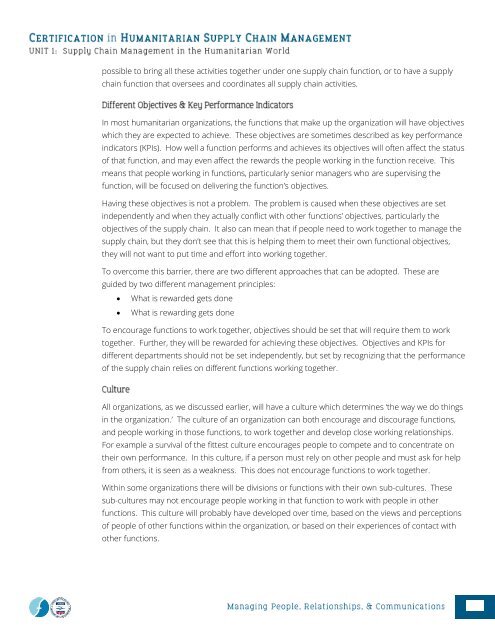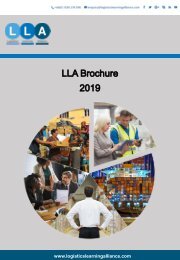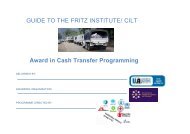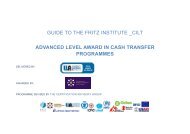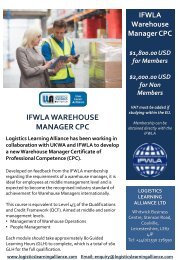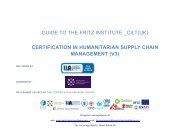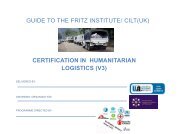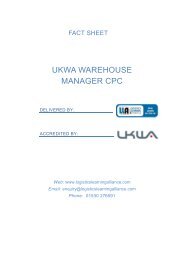CHSCM 3.0 - Unit 1 - SCM in the Humanitarian World
Learning Materials for Unit 1 of the Certification in Humanitarian Supply Chain Management (CHSCM).
Learning Materials for Unit 1 of the Certification in Humanitarian Supply Chain Management (CHSCM).
Create successful ePaper yourself
Turn your PDF publications into a flip-book with our unique Google optimized e-Paper software.
possible to br<strong>in</strong>g all <strong>the</strong>se activities toge<strong>the</strong>r under one supply cha<strong>in</strong> function, or to have a supply<br />
cha<strong>in</strong> function that oversees and coord<strong>in</strong>ates all supply cha<strong>in</strong> activities.<br />
In most humanitarian organizations, <strong>the</strong> functions that make up <strong>the</strong> organization will have objectives<br />
which <strong>the</strong>y are expected to achieve. These objectives are sometimes described as key performance<br />
<strong>in</strong>dicators (KPIs). How well a function performs and achieves its objectives will often affect <strong>the</strong> status<br />
of that function, and may even affect <strong>the</strong> rewards <strong>the</strong> people work<strong>in</strong>g <strong>in</strong> <strong>the</strong> function receive. This<br />
means that people work<strong>in</strong>g <strong>in</strong> functions, particularly senior managers who are supervis<strong>in</strong>g <strong>the</strong><br />
function, will be focused on deliver<strong>in</strong>g <strong>the</strong> function’s objectives.<br />
Hav<strong>in</strong>g <strong>the</strong>se objectives is not a problem. The problem is caused when <strong>the</strong>se objectives are set<br />
<strong>in</strong>dependently and when <strong>the</strong>y actually conflict with o<strong>the</strong>r functions’ objectives, particularly <strong>the</strong><br />
objectives of <strong>the</strong> supply cha<strong>in</strong>. It also can mean that if people need to work toge<strong>the</strong>r to manage <strong>the</strong><br />
supply cha<strong>in</strong>, but <strong>the</strong>y don’t see that this is help<strong>in</strong>g <strong>the</strong>m to meet <strong>the</strong>ir own functional objectives,<br />
<strong>the</strong>y will not want to put time and effort <strong>in</strong>to work<strong>in</strong>g toge<strong>the</strong>r.<br />
To overcome this barrier, <strong>the</strong>re are two different approaches that can be adopted. These are<br />
guided by two different management pr<strong>in</strong>ciples:<br />
• What is rewarded gets done<br />
• What is reward<strong>in</strong>g gets done<br />
To encourage functions to work toge<strong>the</strong>r, objectives should be set that will require <strong>the</strong>m to work<br />
toge<strong>the</strong>r. Fur<strong>the</strong>r, <strong>the</strong>y will be rewarded for achiev<strong>in</strong>g <strong>the</strong>se objectives. Objectives and KPIs for<br />
different departments should not be set <strong>in</strong>dependently, but set by recogniz<strong>in</strong>g that <strong>the</strong> performance<br />
of <strong>the</strong> supply cha<strong>in</strong> relies on different functions work<strong>in</strong>g toge<strong>the</strong>r.<br />
All organizations, as we discussed earlier, will have a culture which determ<strong>in</strong>es ‘<strong>the</strong> way we do th<strong>in</strong>gs<br />
<strong>in</strong> <strong>the</strong> organization.’ The culture of an organization can both encourage and discourage functions,<br />
and people work<strong>in</strong>g <strong>in</strong> those functions, to work toge<strong>the</strong>r and develop close work<strong>in</strong>g relationships.<br />
For example a survival of <strong>the</strong> fittest culture encourages people to compete and to concentrate on<br />
<strong>the</strong>ir own performance. In this culture, if a person must rely on o<strong>the</strong>r people and must ask for help<br />
from o<strong>the</strong>rs, it is seen as a weakness. This does not encourage functions to work toge<strong>the</strong>r.<br />
With<strong>in</strong> some organizations <strong>the</strong>re will be divisions or functions with <strong>the</strong>ir own sub-cultures. These<br />
sub-cultures may not encourage people work<strong>in</strong>g <strong>in</strong> that function to work with people <strong>in</strong> o<strong>the</strong>r<br />
functions. This culture will probably have developed over time, based on <strong>the</strong> views and perceptions<br />
of people of o<strong>the</strong>r functions with<strong>in</strong> <strong>the</strong> organization, or based on <strong>the</strong>ir experiences of contact with<br />
o<strong>the</strong>r functions.


